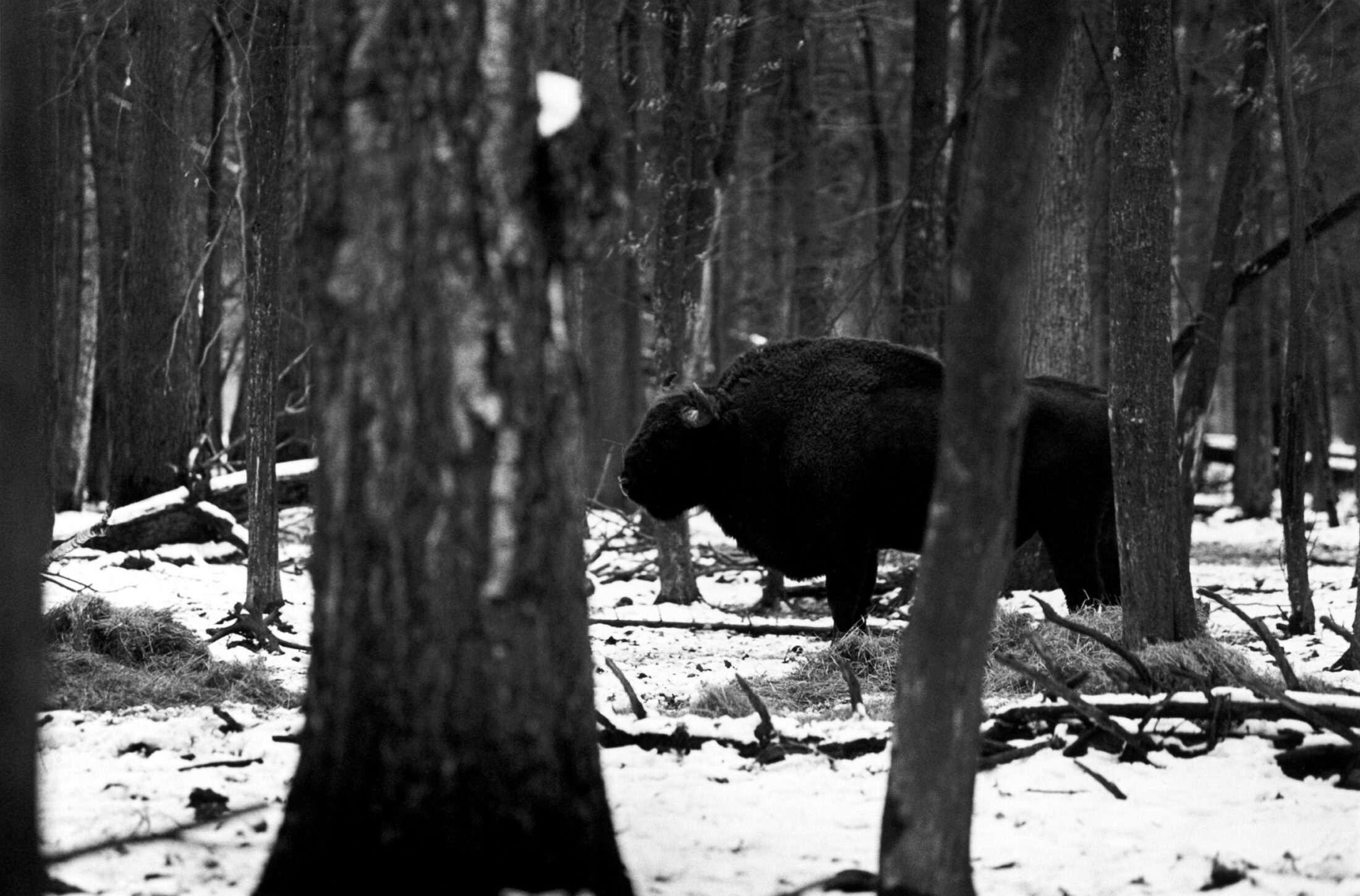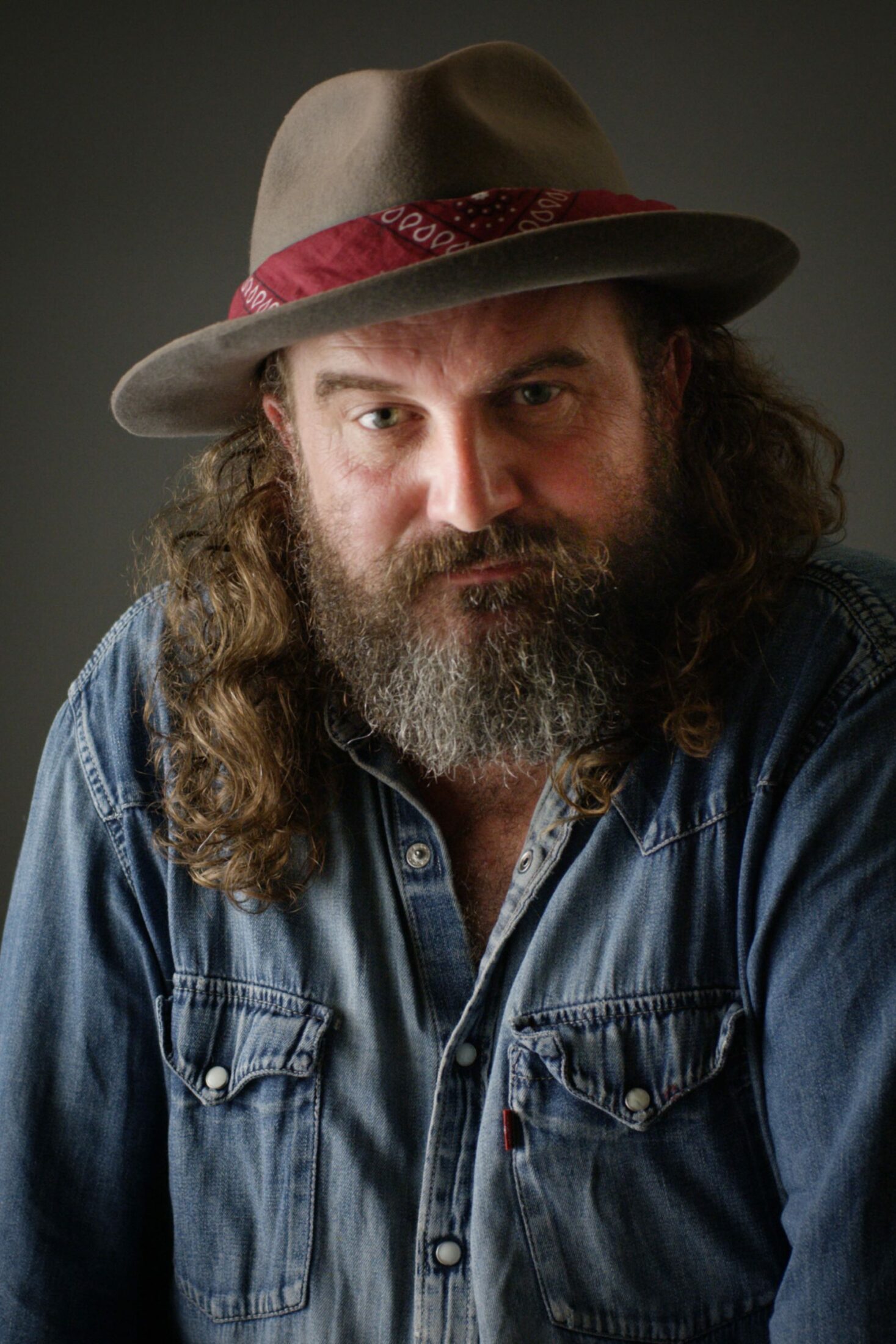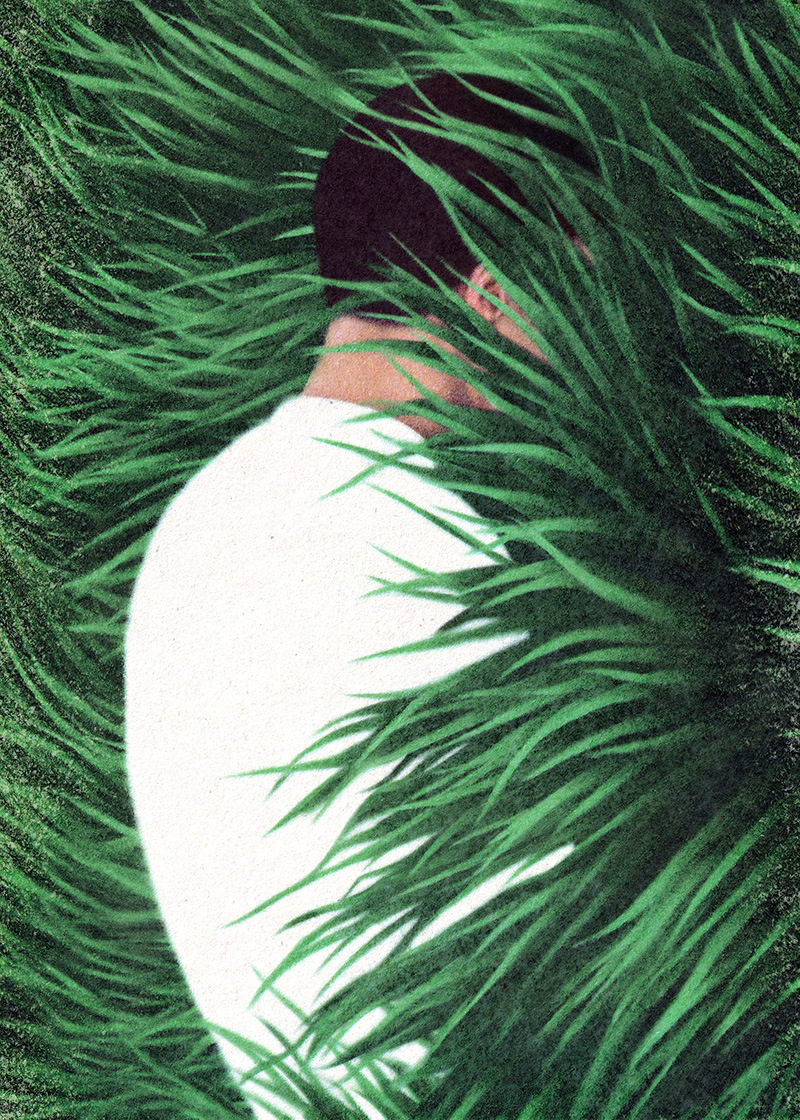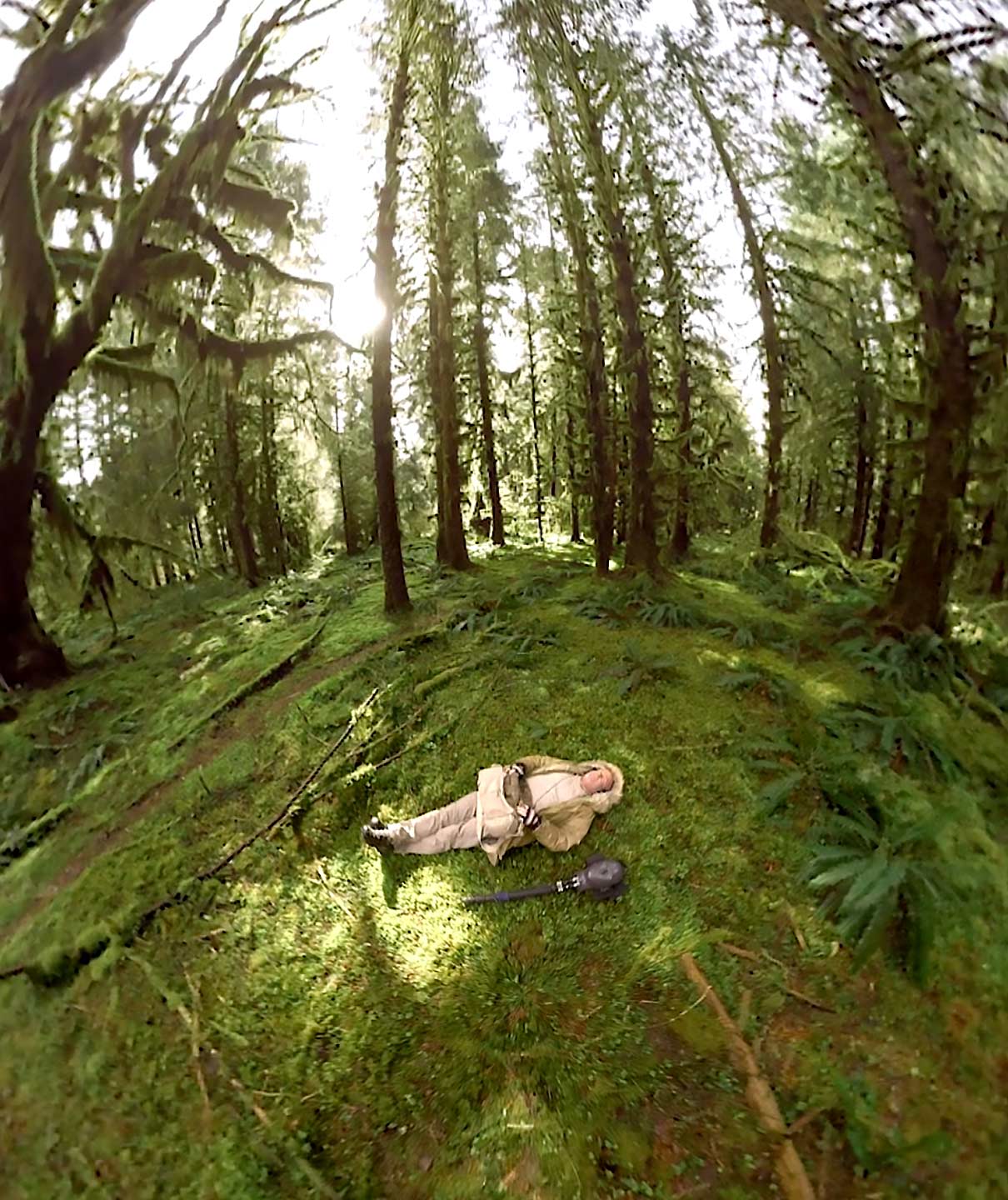
Kara Moses facilitates rewilding for land and people. As an educator, she lectures and facilitates nature connection, spiritual ecology and skills training for social change. She writes about the human-nature relationship and social change and has been published in The Guardian, Resurgence & Ecologist, BBC Wildlife, among others. She is a trustee of the Wales Wild Land Foundation, which is currently focused on rewilding land in west Wales, where she is based.
During a visit to the last true wilderness of Europe, Kara Moses meets a herd of bison, encounters loggers and felled trees, tracks wolves, and observes how a healthy forest is in a constant cycle of death and rebirth. Upon returning to her home in the sheep-grazed moors of Wales, she reflects on the power of regeneration, self-willed landscapes, and the potential for the renewal of domesticated places.
My body is frozen, my eyes wide. I can see, through the trees, shifting shadowy shapes. Muscular hunks of dark black that seem to suck in all light that touches them. I can feel myself being drawn in to a place that is somehow beyond time and space.
Bison. Uncompromising bulk. Magnificent, majestic beasts with a powerful, unapologetic presence. Enormous, hulking shoulders and bulging neck covered in a dark, shaggy coat like a royal robe, in stark disproportion to the velvet-furred slimline rear quarters. Atop the bullish head, striking horns curve and point toward each other as if in self-reference, intensifying the animal’s profound presence. There are at least fifteen of them, including some young, grazing quietly. Peering from behind a tree trunk so as not to disturb them, I realize I am holding my breath. I exhale and shift my weight slightly; a brittle twig snaps beneath my feet. A crowd of enormous dark heads lift and turn to face me, small eyes flickering interrogatively. A shiver of fear flashes through my belly. Do bison charge?
But what is conveyed through their steady gaze is not a threat but an invitation, to a time countless generations ago, as if a dozen dark mirrors were reflecting part of myself back through the ages.
This is the last true wilderness of Europe, a precious remaining fragment of the ancient wildwood that once stretched across this great continent. What remains today is a 579-square-mile primeval forest that straddles the border between Poland and Belarus, not that this ancient ecosystem has any regard for human notions of borders and nations. With its characteristic stands of oak, lime, hornbeam, mixed with areas of pine, spruce, wet alder, and ash forests, Białowieża is a rare, natural example of mixed deciduous temperate forest. With some areas completely untouched by human interference and directly descended from the forests that covered this land ten thousand years ago, Białowieża is a unique remnant of old-growth woodland in Europe, and as such was given World Heritage Site status in 1979.
The forest throngs with 12,000 known species of fauna, 1,070 plant species, and 4,000 species of fungi, though only half of its species are estimated to be known to science. Białowieża owes its incredible diversity to its location at a unique intersection near the geographical center of Europe, where the great biomes of the continent and their associated species converge: the northern tundra, the temperate forests, and the steppes of the south encounter each other here at the far reaches of their ranges. Such places where different habitats assemble are often the most diverse in an ecosystem. A center of margins and edgelands, the heart of this continent is complex, abundant, and wild.
The roots of the word “wild” are thought to be found in welt, meaning forest or wildwood and willed. To be wild is to be wooded, to be willed. Self-willed, self-determined: not under the will or rule of another; unruly, uncontrollable. On a continent once almost entirely wooded—where, over millennia, humans have altered, managed, and destroyed forests so extensively—there are few that can be described as truly wild. Białowieża, however, has retained a level of self-determination; the cycles and processes that this forest operates by are beyond the realm of human constructs and control. It has a momentum of its own, a wild sovereignty.
Białowieża is one of the few European forests through which key natural processes, the lifeblood of a healthy ecosystem, still flow freely. These processes, such as the cycle of regeneration, allow a forest to regulate itself. To regenerate is to grow again after death or damage: the renewal of the old into the new. Regeneration flows and pulses through dynamic interactions between predator and prey, growth and decay. This forest is continually dying, and continually being reborn. Death is an essential part of the regenerative process, the raw material from which new life is created. In human-managed forests, dead trees are often removed, “tidied up,” or extracted for timber. The forest is robbed of the nutrients held in the fallen trees, and the cycle of regeneration is broken. In Białowieża, however, there are almost as many dead trees as there are living ones, providing vital raw material for the generation of new life and habitat for thousands of species. Half of the forest’s species depend on this deadwood; the abundance of it is what sets it apart from managed forests.
To be wild is to be wooded, to be willed. Self-willed, self-determined: not under the will or rule of another; unruly, uncontrollable.
Białowieża also retains key agents of regeneration, such as wolves, whose presence has profound effects that echo throughout the ecosystem, known as trophic cascades. As they prowl the forests, they keep their prey on the move, creating a “landscape of fear” that prevents any one area being overgrazed. Grazers like deer can prevent forest regeneration if they stay in any one area for too long, feeding relentlessly on young trees that struggle to become established. If the wolves are exterminated, as they have been across much of their range, the number of grazing animals increases, and their relative safety causes them to move around less. This can ultimately mean the loss of huge areas of forest, the effects of which are far-reaching: widening circles of species loss; soil erosion; flooding. These dynamic interactions between species are the strands which hold the ecosystem together, giving it resilience—the ability to recover from shocks and disruption. When we start undoing these strands, things start unraveling in unpredictable and uncontrollable ways. The forest loses its ability to self-regulate and so loses a level of self-determination. It is de-wilded.
Beneath the thick canopy of trees, the bison and I stare at each other for what feels like an eternity, before they seem to accept my presence and resume their grazing. The afternoon sun stretches lazily through the forest, melting all it touches into soft golden haze. Long, dusky shadows are thrown across the forest floor, as if the trees had shrugged off a layer of loose clothing. The crisp air has a deep, loamy forest freshness to it, the smells of fallen leaves and rotting wood re-merging with the rich black soil. The sound of drilling woodpeckers rattles through the air from high up in the canopy. The pulse of life is palpable here; I can feel my body responding, mirroring the vitality. For a brief moment, I feel I am not myself but just one of a thousand sensations of the forest.
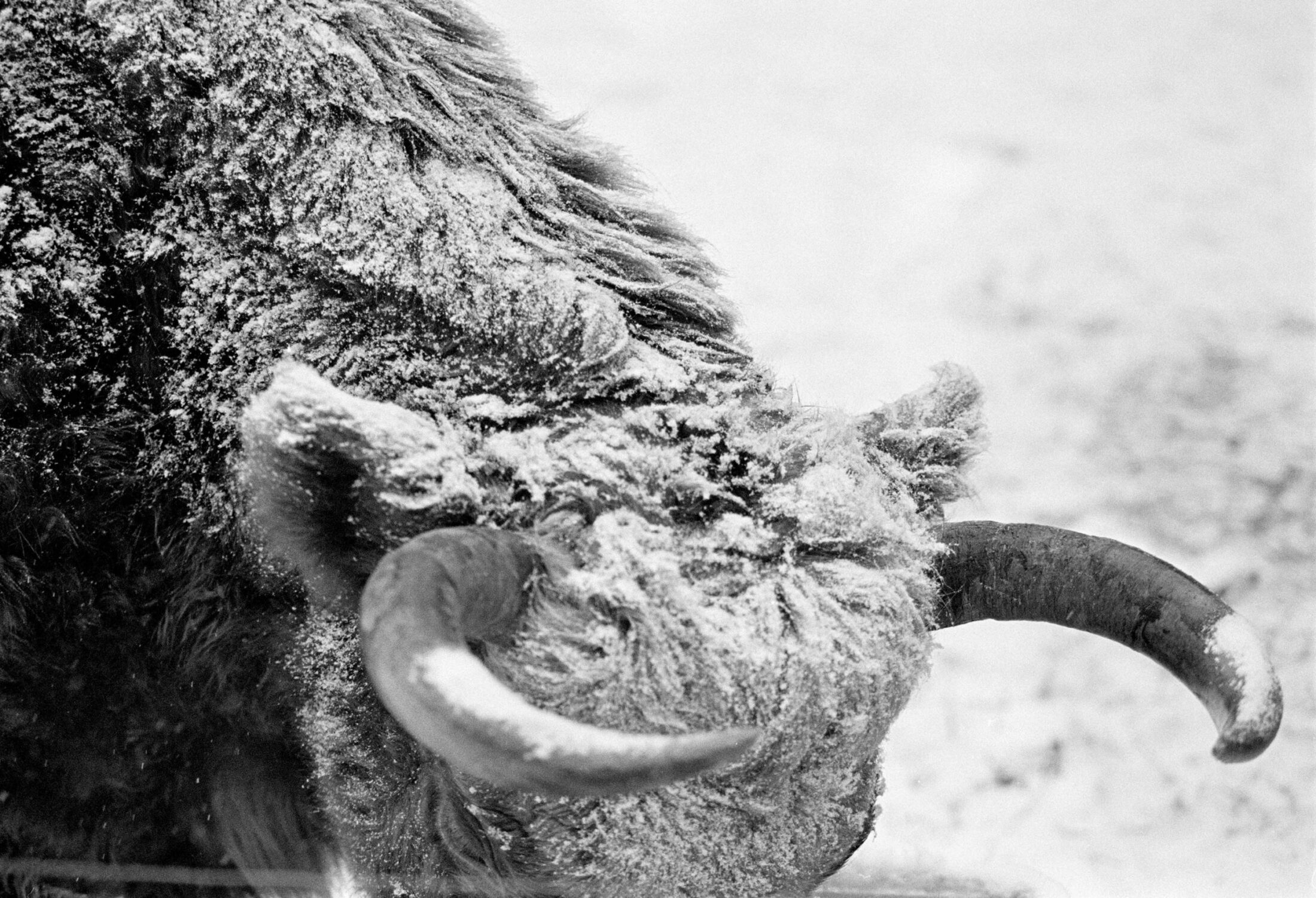

Photos by Stuart Franklin / Magnum Photos
During my years as an environmental activist, I saw only a world on fire: another fracking site opened, another airport expanded, another forest destroyed, another environmental law scrapped. I couldn’t bear to stand by and do nothing, and so I fought. Protests, encampments, marches, time in jail cells, always a thousand more places to defend. In the endless firefighting, I forgot to tend to my own wild fire, the spark of love and hope that had once inspired me to act on the earth’s behalf. But the grueling years exacted steep payment, and the spark slowly extinguished, vanishing into the surrounding dark. For several years I had been unable to find my way back to activism. Eventually, whether by intuition or by some unarticulated question, I came instead to Białowieża, to the forest.
It is late afternoon. The forest falls into uneasy silence, the rich tapestry of bird calls suddenly muted. A rumbling growl rolls through the trees, like a low mist. A convoy of vehicles emerges: timber-harvesting machines, escorted by government forest guards with guns, body armor, and stern faces. Some hang from the machines in nonchalant macho display. A harvester begins work, moving mechanically into the trees, rolling on tracks like a military tank. It slowly extends a long arm, lifting a bulky head with menacing metallic jaws—resembling a theme-park dinosaur—into the air. It grabs a sixty-foot-tall spruce tree, effortlessly slices through the trunk, and pulls it toward the sky, throwing it around like a child’s toy. The tree is yanked through the jaws, stripped of its branches, bitten up into logs, and spat out the other end.
Białowieża has become an iconic battleground between those who make a claim on how—or if—the forest should be managed. Polish state foresters, environmental activists, scientists, locals, and European Union policy makers all contend for the fate of the forest. In March 2016, the Polish state forestry department had already reached its timber quota for the year in Białowieża. Rather than adhere to the quotas and stop the logging, the government instead permitted a tripling of timber quotas and legalized logging in old-growth areas. Large-scale logging began amidst uproar from scientific and environmental communities.
As the state foresters closed in with their timber harvesters and word spread about what was happening, thousands of people from across Europe came to defend the forest, or the puszcza—wild forest—as the Polish call it. A protest camp was set up. Every day, for almost a year, people blockaded the forest roads, locked themselves to harvesters, patrolled the forest, and reported logging activity to European authorities. The European Commission responded by filing a lawsuit against the Polish government in 2017, calling for an immediate halt. Poland brazenly declared it would not heed the orders and continued. Forest guards, a branch of the Polish police force who protect forestry resources, arrived to patrol the forest for activists. Journalists came with cameras and microphones. The previously tranquil forest was awash with human activity. The conflict played out in courtrooms and police stations, on TV and in newspapers, in city offices and rural village halls. The story of the battle for Europe’s last primeval wilderness was reported around the world. Białowieża became not only a convergence of biomes, but a place of encounter between self-willed land and the human desire to control it, between wildness and domestication.
The Polish government insists that the logging is necessary to control a spruce bark beetle outbreak that is rapidly spreading through Białowieża. This claim is hotly contested by scientists, conservationists, activists, and UNESCO, who accuse the government of profiteering and say that removing dead trees is more damaging to the forest than the beetle itself.
The spruce bark beetle, an innocuous-looking invertebrate that eats its way under the bark of spruce trees, is naturally present here, and the forest has its ways of managing fluctuations in its population. Wild boar, for example, feed on the beetles as they rummage in the ground. Their disturbance to the soil also allows new trees to establish, helping the forest regenerate. Having evolved alongside the beetle, spruce trees can defend themselves against attack by oozing chemical-filled resin. Left alone, the forest is able to manage a bark beetle outbreak, as it has done for millennia. However, outside of protected areas—a mere 17 percent of the forest on the Polish side—human interference is exacerbating the current onslaught of beetles. In areas where spruce has been planted for timber, the proportion of spruce is artificially high, allowing the beetle to spread more rapidly. Thousands of wild boar were killed in an attempt to control African swine fever, which spread into Poland in 2014. In their absence, trees are struggling to establish themselves in open areas after logging or spruce infection.
A few days into my week in Białowieża, I go to see some of the worst damaged areas of the forest. Along the dirt road, piles of timber are stacked as high as double-decker buses, and a wide swath of trees has been cleared, continuing as far as I can see. Where once stood ancient forest, there are now only stumps and a tangle of mutilated branches. The remaining trees tower around the cleared areas, as if mourning. I walk through the devastated landscape, touching the tree stumps. Running my fingers across the growth rings, I feel the story of the vast lives they had lived, written in concentric circles. Some are over a hundred years old. Here a thick ring of a good year, perhaps warm and wet; there a narrow ring of leaner times.
How do humans feature in these stories? We can be worshippers, stewards, protectors, destroyers, exploiters, managers. For these felled trees, we bring an ending—the accumulation of the growth ring–chapters brought to a close. And yet, the great and ancient story of the forest continues.
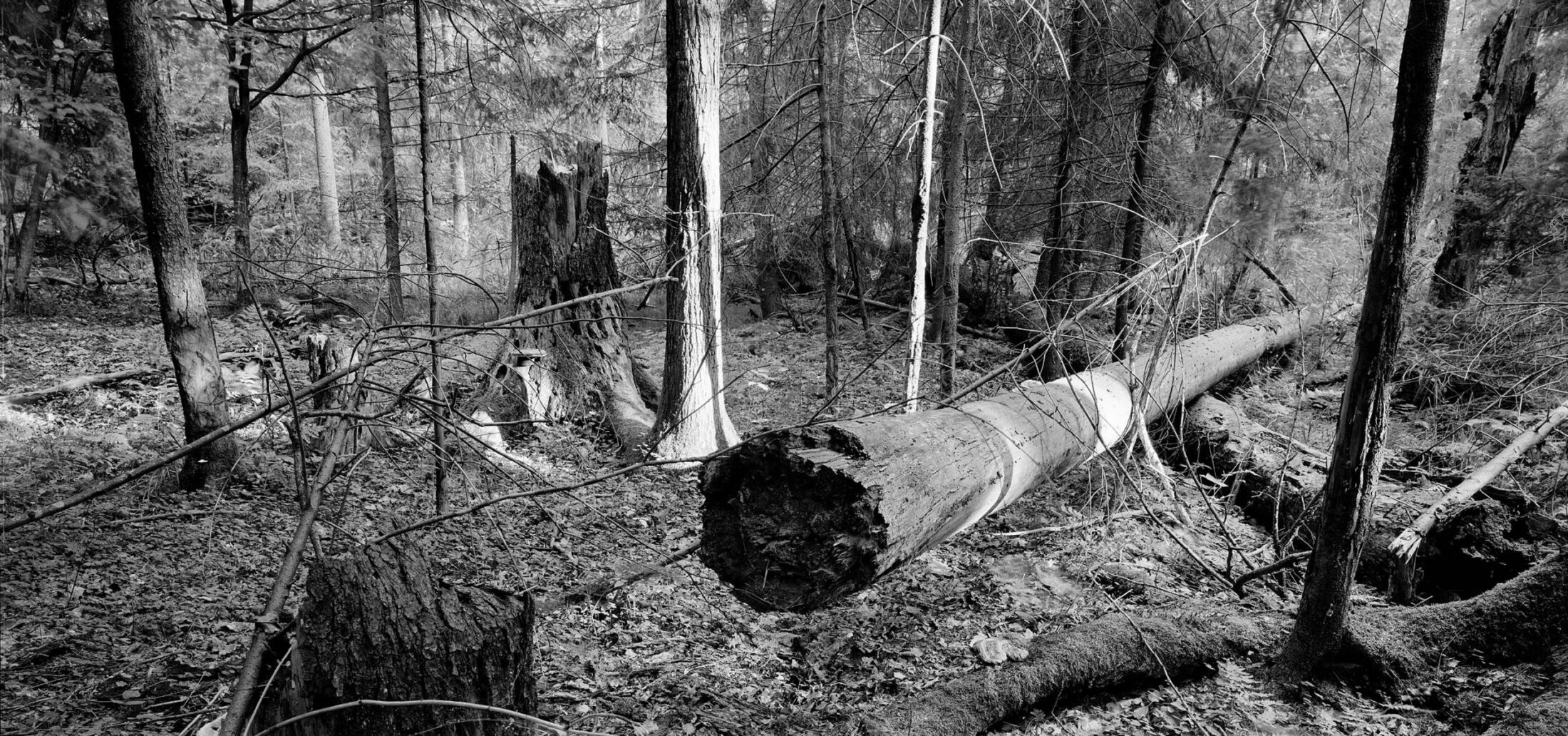
Photo by Stuart Franklin / Magnum Photos
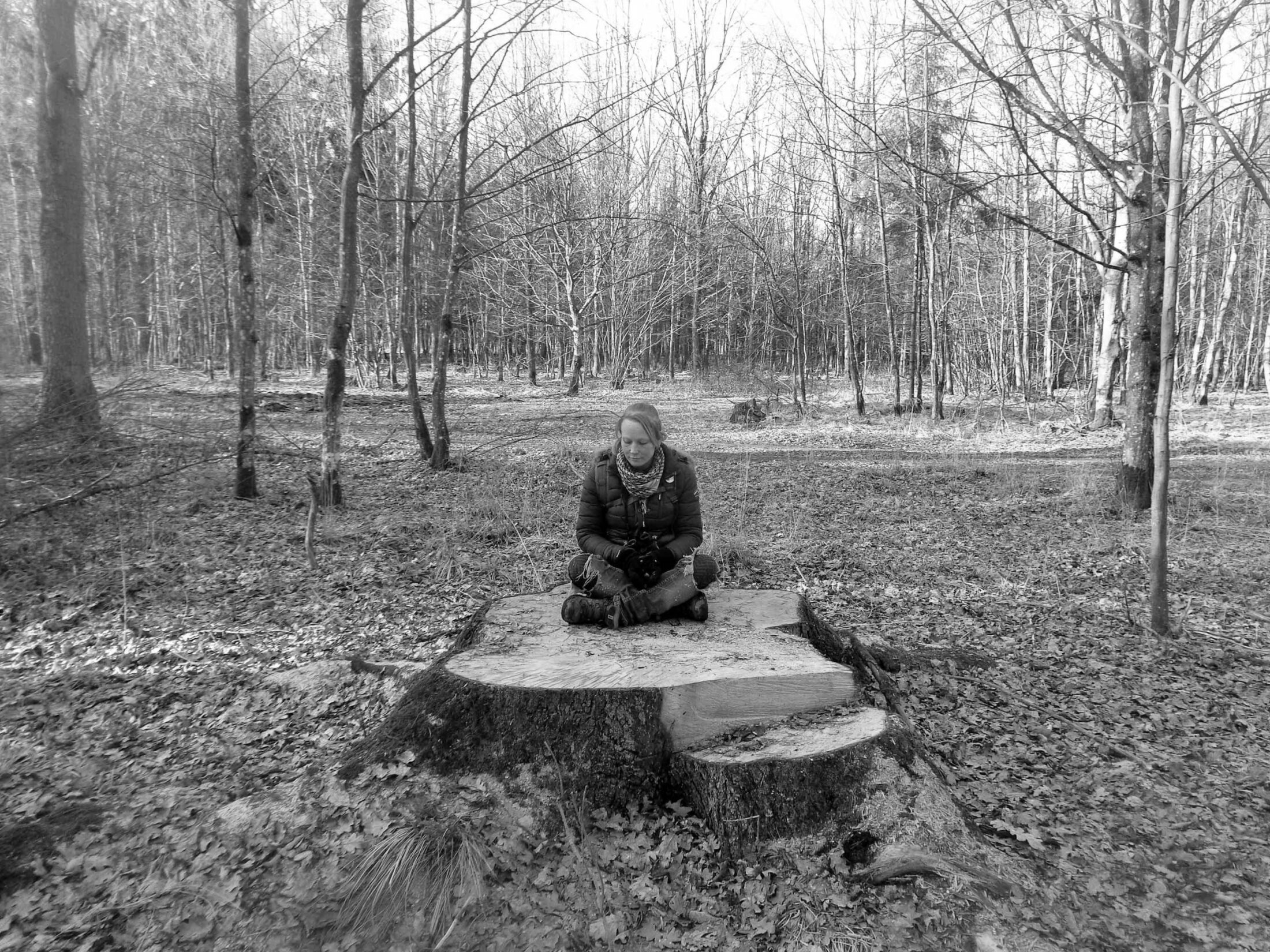
Photo by Kara Moses
The snow has come to rest in a thick blanket of silence, bringing an enchanted air to the forest. A network of animal tracks laces through the snow; the creatures of the night have been on the move. Secrets of the forest are revealed, as if a great white newspaper was spread across the land reporting the events of the night. Moments that no human eye witnessed are now vividly replayed in front of me in glistening white.
The first tracks I see are neat and familiar: red fox, an adult male. He walks softly from among the trees into an open area, when something catches his attention. He pauses suddenly. Paw hovering in the air, just brushing the surface of the snow, he looks to the right. His whole body is poised and alert, black-tipped ears pricked, dark nose twitching, golden eyes scanning. Spooked, he turns and briskly trots away, making a heroic leap over a ditch, slipping slightly as he lands on all four feet on the other side. He disappears into the trees, leaving no more tracks, as if he had melted into the forest.
A badger trundles along at dusk, snuffling in the snow-covered leaf litter. Occasionally, she stops to dig up mouthfuls of juicy grubs and crunchy beetles with her strong claws. She returns later that night along the same trail; badgers are creatures of habit. I follow the trail, which leads to an enormous sett many meters across. The sett is so old—perhaps passed down through generations for hundreds of years, as badgers do—that it has landscaped a whole area. The ground hollows and dips where old tunnels have collapsed and rises into mounds with newer heaps of earth dug up from beneath the forest, between the roots.
A whole world is revealed to those who learn to read the minute details of tracks: species, sex, age, speed, which direction the head is turned, even how they are feeling—scared, calm, hungry. Catch a thread, follow it through, and a story begins to unfold. The mystery draws you in ever deeper, to a hidden world. The master tracker becomes the animal they track, sensing into the animal’s experience until the boundaries between human and animal, tracker and the tracked, become blurred, and they no longer need to look at the tracks to know where the animal is headed.
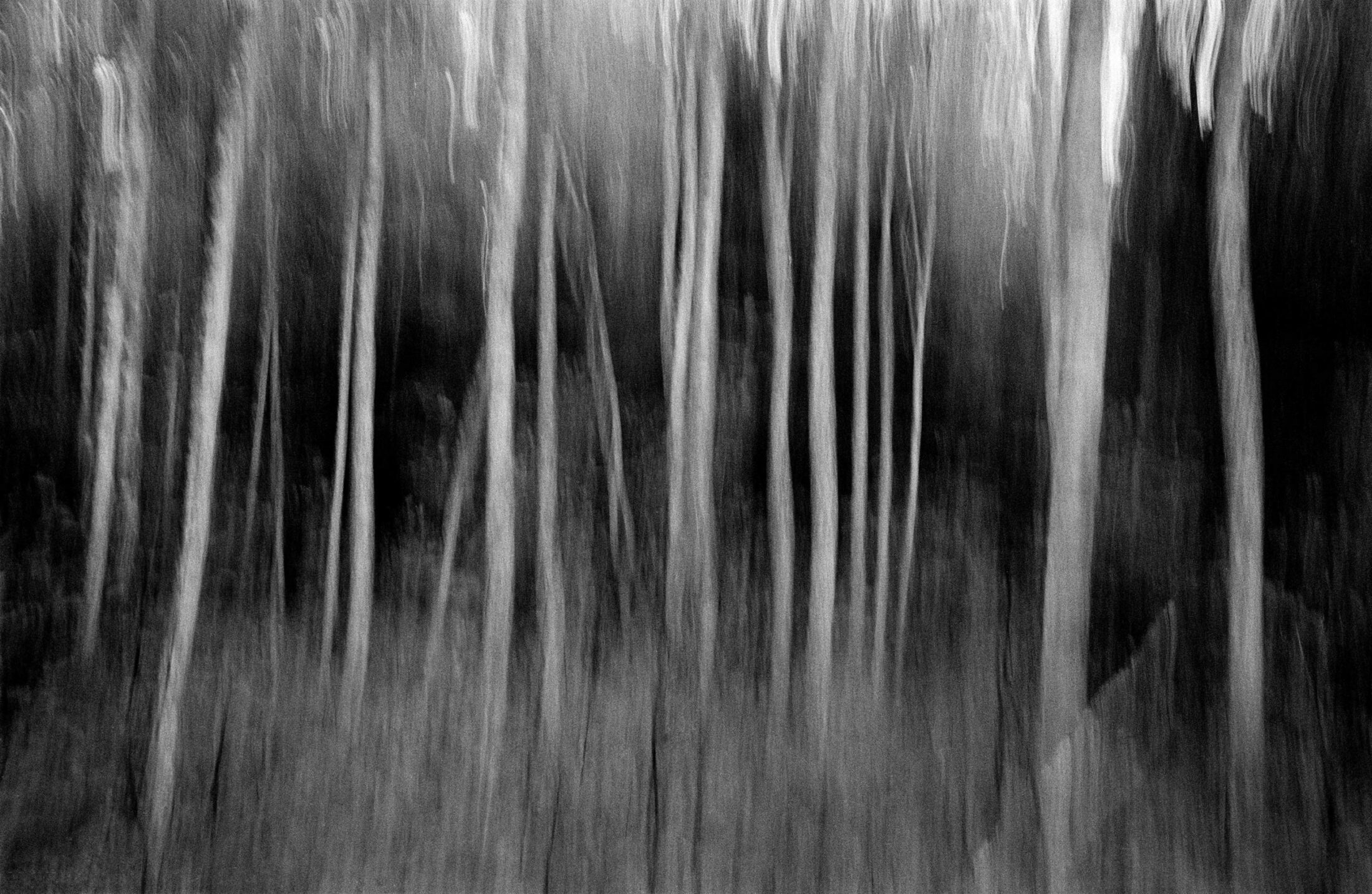
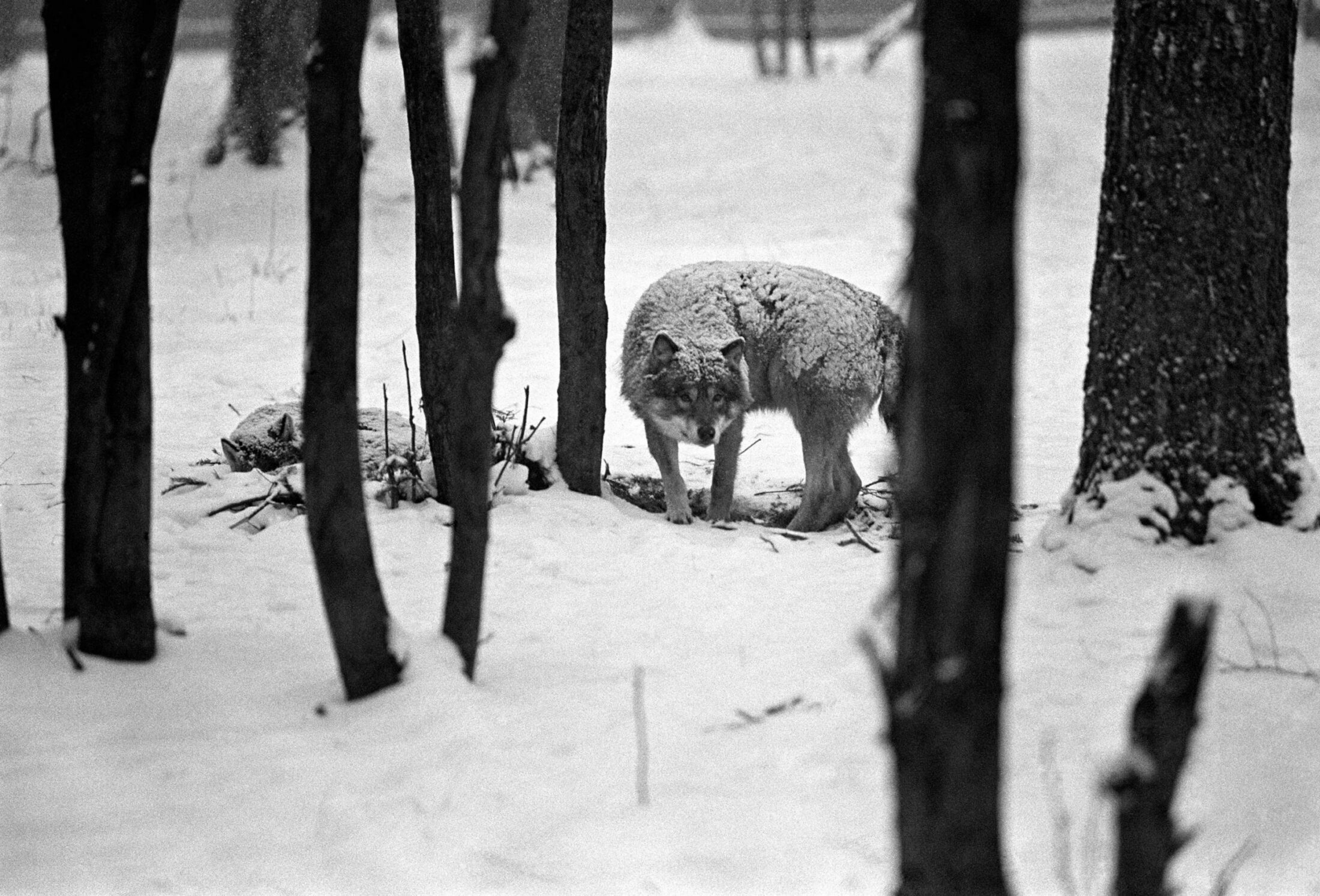
Photos by Stuart Franklin / Magnum Photos
A pack of wolves are on the prowl. There are just three: two females and one male. Unhurriedly, they trot along in that distinctive wolfish manner, shoulders swinging, head low. They follow the human trails and forest roads. Their enormous tracks crisscross over each other as they silently trail each other through the forest, sometimes moving in single file and close together, sometimes splitting off to investigate something, perhaps an intriguing smell. Occasionally, they come to a stop in one place for a while, padding around, perhaps smelling the air for their prey.
I trail the wolves for hours through the snow. Utterly absorbed, I am pulled deeper and deeper into the forest, off the road and into the trees. The snow eventually begins to melt in the bright sunshine of the afternoon, and the tracks begin to slump and turn translucent, as if tired of storytelling. I have been walking for hours now; my legs are heavy and the light is fading. I come across a great fallen oak, brought down from its royal heights to lie among the detritus on the forest floor. Oak trees can live for hundreds of years, and can take hundreds of years to die. I wonder how long this tree has lived, how long it has been dying, whether it is truly dead yet. On its thick trunk and all around, new life is sprouting: a sprawl of lichens, young trees vigorously springing up, a carpet of ground plants, ferns sprouting like feathers. It is as if a great whale of the sunlit waters above has died and sunk to the ocean floor, attracting a carnival of creatures to feast on the banquet.
I walk to the base of the trunk and peer inside. There is a central cavity so large I can climb inside and sit upright. I crawl in. Other animals have taken shelter here: mouse-nibbled hornbeam seeds and squirrel-cracked hazelnuts are scattered around alongside a strand of deer hair and a few droppings. Some of the walls inside are a bottomless black, the long fibers shattering into charcoal-like cuboid shapes. Brittle and crispy, it crackles and crumbles as I run my cold fingers over it. The tough, sinewy heartwood bulges and swirls in stormy seas.
The cavity reaches deep inside the trunk of the tree, disappearing into darkness after a few meters. On hands and knees, I crawl deeper inside, lie down, and rest. Here in the heart of this ancient tree, in the heart of the wildwood, my own heart is steadily pulsing along with the life that flows through the forest. My body meets the fibrous interior of the tree, which extends to the roots and reaches into the dark earth, and beyond.
I spend the whole night inside the tree—holding a vigil for the wild, far away from the clamor of the conflict. The moon, full to bursting, sings her silver velvet song to the earth, while a blaze of dazzling stars dance across the night sky. The wolves sound in the far distance, the howling cry of wilderness echoing down through the ages, as if to remind us of who we once were; who we could be again. Calling us back into the family.
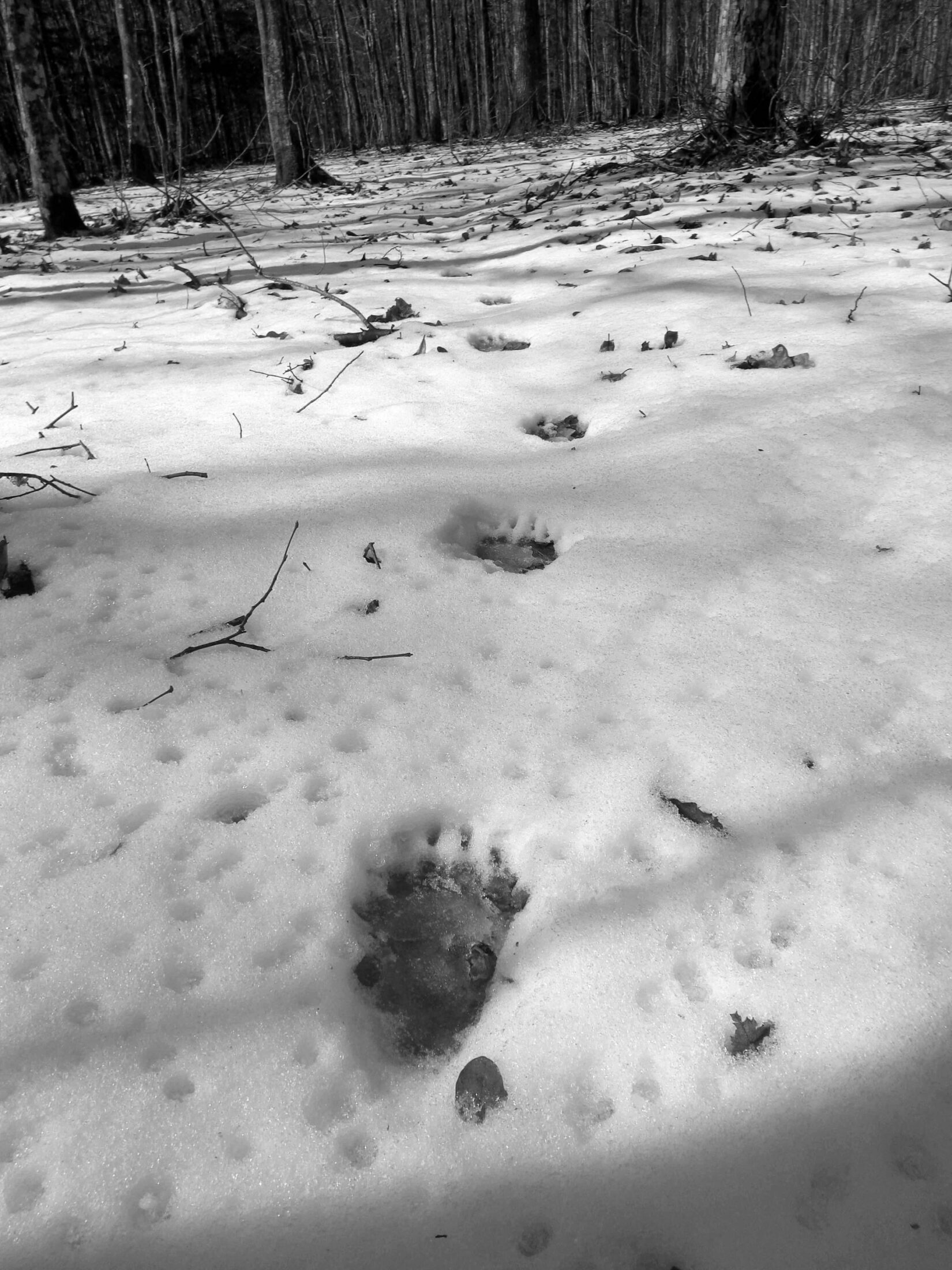
Photos by Kara Moses
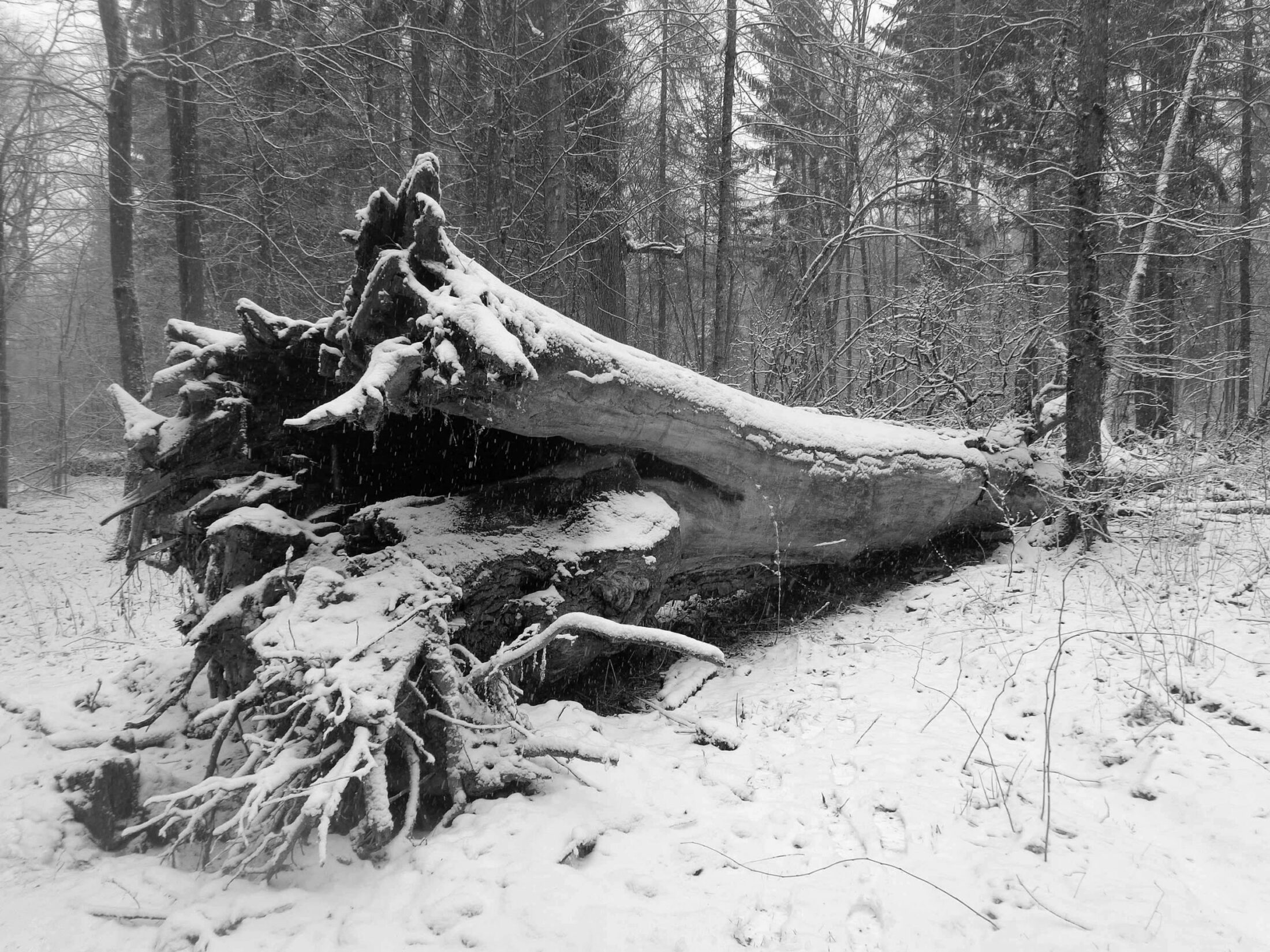
The sweet sound of birdsong seeps into my awareness, tugging at the sleeves of my slumber. The sunlight is already warm—unusually warm for springtime in Wales. Last night I slept on a bed of moss, gazing at the glimmering sky through the branches of a magnificent oak. Again I experienced that strange sense of peering back through time, as if the bison had opened up a channel through the ages that I could still glimpse through.
I am back at home, spending some time out on rewilding land, still dreaming of Białowieża. When I first arrived home, I was desperate to return to the forest. I longed for the bison, the wolves, the ancient oaks. But I decided to trust that the puszcza had imparted its small gifts, seeds to cultivate and carry forward.
The winds from the Irish Sea howl and whip across this Welsh moor, with no trees left to impede them. This land has long been stripped of her forest garments, every secret curve exposed, her rocky bones showing through. A monoculture of purple moor grass stretches endlessly over the rolling hills and jutting valleys, interrupted only by regimented blocks of alien sitka spruce plantation. The moor grass is so unappealing to wildlife that hardly any birds or animals will live in it, and not even the sheep, which eat everything else, will eat it. A bird survey conducted last year found one single species: the meadow pipit, the only bird to be found for miles around. Each year, the thick moor grass tussocks die and flop down, smothering everything else, draining the landscape of all color but a sickly jaundice yellow. Walking on the moor grass is almost impossible, an infuriating and exhausting experience; you never know whether your foot will wobble atop the tussocks or disappear between them.
Like so much of our island, the wildwood here was cleared until nothing of it remained. Intensive animal agriculture now dominates the landscape: a sheep-wrecked green desert. Many of the natural processes that pulse through Białowieża no longer function here. There are barely any predators left—no bear, no wolf, no lynx. There are no grazing bison or deer, no wild boar rummaging through the soil, no beaver engineering the waterways. It is a curious thing that many of the species we have exterminated here are those that would play key roles in regeneration. And so the task now falls to us.
Over the past few weeks, a group of us have begun rewilding this area in the foothills of the Cambrian Mountains in West Wales. This hundred-acre site—a “big soggy hill,” as one person described it—covered in purple moor grass and not much else, was recently bought by a small charity with a vision to restore the great Cambrian wildwood that once covered these mountains.
Rewilding is about regenerating and restoring landscapes and their processes, creating healthy, functional ecosystems that can become self-regulating and free-willed again. There has been no human intervention here for seven years—even the sheep farmers gave up trying to make a living from these barren hills. After millennia of being suppressed by human will, the will of the land has begun to return in just a few years, oozing through the cracks and crevices in all its glorious forms. Mountain ash, birch, hawthorn, and oak are quietly emerging through the moor grass and the bracken. This land has not forgotten what it is meant to be. Like steam rising from hot water, new life rises from the land, from the memory of what it once was, what it still longs to be. The wildwood is returning.
One of our first jobs was ripping out the internal fences to create a core area that will allow free movement of wildlife—when it returns. In driving rain and scorching sun—sometimes both in one day—we pulled out fencing staples, cut through barbed wire, and laid fence posts down to return to the earth. Beneath the necessary work of restoring destroyed landscapes is perhaps another work that rewilding asks of us: to step back into the family of things—to participate. In doing so, we engage in a practice of reciprocity, going beyond the limitations of “sustainability”—which maintains a level of taking—and enter a regenerative relationship with the wild again. We give as much as we take—if not more. Ripping out the fences was exhilarating: it felt like a sacred act, an apology, a reconciliation. By liberating the land from these boundaries, its containment into sizes and shapes for human control, on some level we also liberated ourselves.
Beneath the necessary work of restoring destroyed landscapes is perhaps another work that rewilding asks of us: to step back into the family of things—to participate.
Although there is no “true” wilderness in any of the landscapes I know as home, I have come to realize that wilderness is not a pure state that once defiled can never be attained again. The will of the wild remains dormant in the land—and within us—waiting for her time to come again. Wildness does not have to mean the absence of human agency; we can participate in it, aligning human will with wild will, a symbiosis that heals both land and human spirit.
By the time I come to write this, the logging in Białowieża has been stopped and the forest is safe for now. Protesters were acquitted, deemed to be acting for the public good. It is not yet known how much of the forest was damaged. It occurred to me that the people who disobeyed the government to defend Białowieża had aligned their will with that of the forest. When I asked the activists how they coped with such fraught conflict, many of them told me that Białowieża itself sustained them: the forest was helping them to help the forest. They, too, were nourished by the relationship.
On a day in early spring, beneath a sun that is unabashed and warm, I come to a gatepost at an intersection of fence lines, the next to be pulled from the ground. But something catches my eye: an abundance of mosses and lichens are thriving atop the rotting oak—a small ecosystem. From this elevated oasis, a young mountain ash, its seed probably deposited by a bird, is growing, sending its roots down into the post. Mountain ash is a pioneer species, one of the first to establish in disturbed ground, preparing the soil for other species to follow. This old, rotting oak post, former upholder of human control, is being reclaimed, regenerated, seeded by the wild itself to create fresh new life from the old. I walk on, leaving the post where it stands, leaving it to liberate itself.
